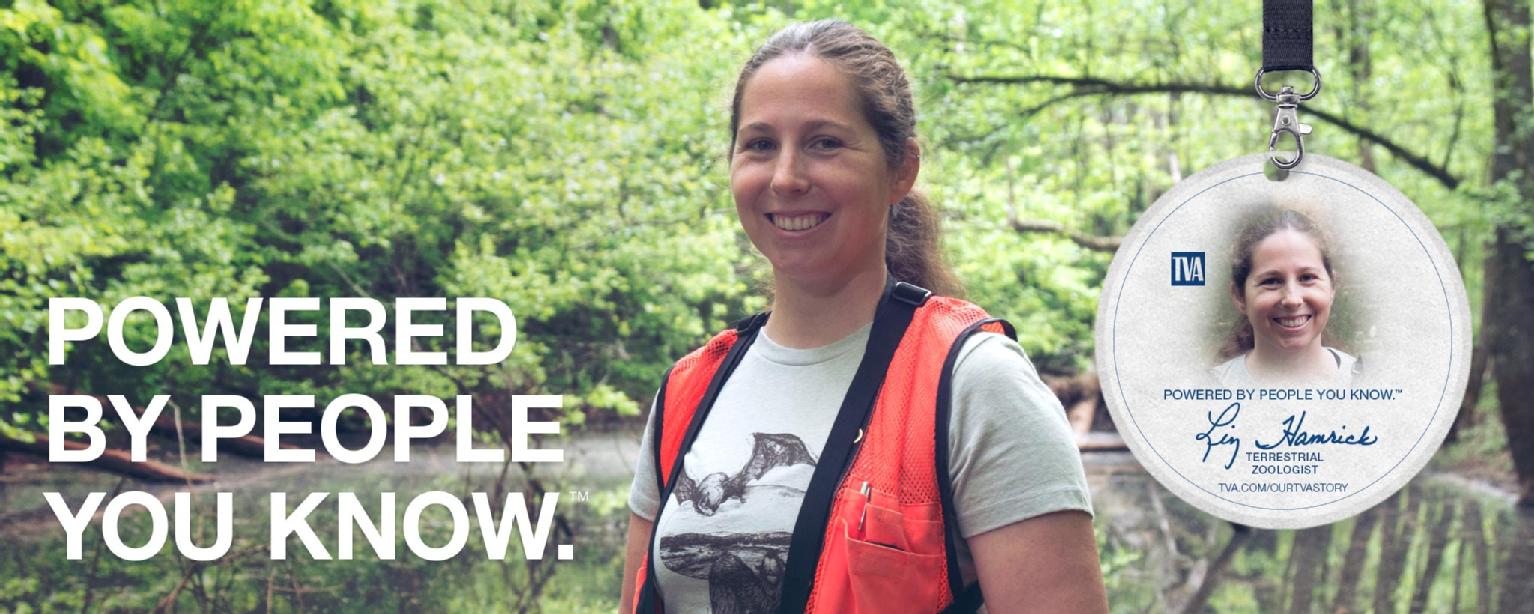Liz Hamrick
TVA Zoologist | Knoxville, Tenn.
I'm lover of nature. I love that my job gets me outside exploring nature. Going into bat caves is some of the most exciting work I get to do. It feels like you’re looking into a secret world you get to witness. I's pretty special.
Call her bat girl. She won't mind—Liz Hamrick cares deeply about this underappreciated species, and as TVA zoologist, spends about 50 percent of her time focused on saving bats. “TVA is part of a multi-agency effort to investigate the cause and spread of bat deaths associated with white-nose syndrome,” Hamrick said. “Seven bat species, including two endangered species and one threatened species, have been confirmed with this devastating disease, which has already killed an estimated 6 million bats in eastern North America.”
Hamrick said her workload has more than doubled since white-nose syndrome, named for the white fungus on the muzzles and wings of affected bats, was confirmed in bat hibernation sites in the TVA region.
“There are a lot of cave resources on TVA-managed lands so we have an important role to play in bat protection,” she said. “All TVA caves are closed to public use because humans can spread the fungus from cave to cave when it gets on their clothes and boots. Human activity also disturbs sick bats struggling to stay alive through the winter.
“We also manage the forested land in our care to protect the summer roosting habitat of endangered Indiana bats and threatened northern long-eared bats. Both these species give birth to their young pups under the peeling bark of dead and dying trees. Every time we take an action that could affect summer roosting habitat—even one as simple as clearing a small area for a new boat dock—we try to make sure bats aren’t affected.”
In addition, TVA is actively involved in monitoring bat populations in the region, said Hamrick.
“In winter, we go into caves, count bats and swab them to see if they have the fungus. Our data supports statewide and continent-wide efforts to monitor population declines and the spread of the fungus. In the spring, we help our federal, state and private partners in monitoring the migration of Indiana bats.”
Love them or hate them, Hamrick said bats benefit humans in important ways.
“A single bat can eat up to 8,000 bugs every night, which is a tremendous economic benefit to the agricultural industry. Without bats, farmers would have to spray a lot more chemicals on crops. Bats also are essential to some desert and tropical ecosystems, where they pollinate plants that provide the fruits and nuts we all enjoy.”
The other half of Hamrick’s job is reviewing TVA projects for impacts to wildlife—projects ranging from permitting a new boat dock to large-scale economic development projects. She is currently working on a project to construct 42 miles of new transmission lines in Mississippi.
“We are in the process of walking all 42 miles looking for potential impacts to known rare species in the project area. We look for caves and for eagle, osprey and heron nests. We flip over logs to look for rare reptiles and amphibians. We try to identify birds in the area by sight and sound and animals by their footprints, scat and marks they make in the ground and on trees. Then, back in the office, we’ll map areas that need to be protected and propose restrictions or commitments to avoid or minimize impacts to protected species.”
With her love of animals and the outdoors, the job is a good fit for Hamrick. She's been able to travel—studying possums in the Australian rainforest, and frogs, bats and birds across Costa Rica. She assisted with a research project examining the extinction rate of lemurs in Madagascar. She worked on an endangered bird project in the cloud forests of Maui. And she loves what she learns.
“It allows me to observe and enjoy the natural world and to help TVA do the right thing for the environment,” she said. “That keeps me going.”
Hamrick shares her love of the outdoors with her husband, Michael. In fact, he proposed to her three years ago on a whitewater rafting trip on the Middle Fork of the Salmon River, a protected river in Idaho.
“Michael wasn’t himself on that trip,” Hamrick recalled with a laugh. “I thought he was nervous about paddling such big water. But it turned out he was waiting for the right moment to ask me to marry him. I’m not sure if he was more worried about my answer or flipping the raft and losing the ring.”
The couple is looking forward to a second trip on the same river this summer. They also enjoy hiking, camping, mountain biking, rock climbing and live music.
Meet More People You Know
Meet more TVA employees, and learn about some of the fascinating ways they serve the Tennessee Valley through their work in energy, environmental stewardship and economic development.
They’re your friends, your family, your neighbors. Get to know them.
